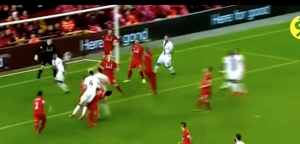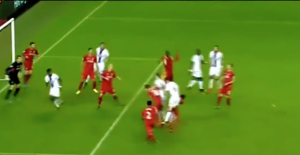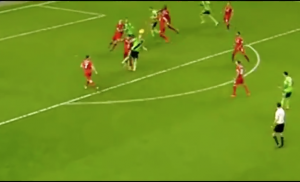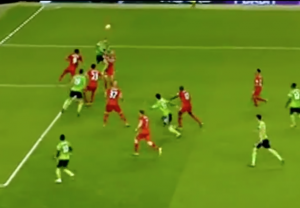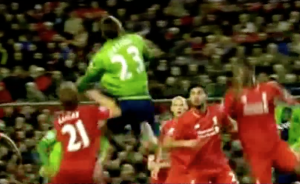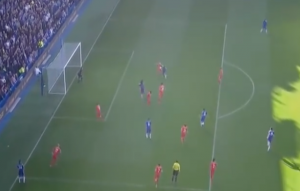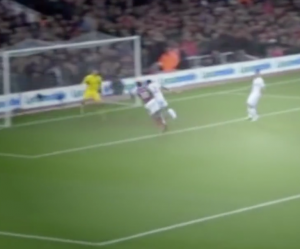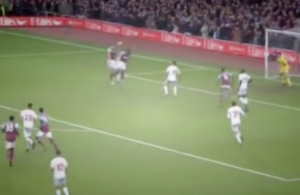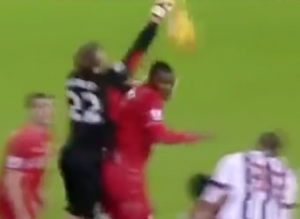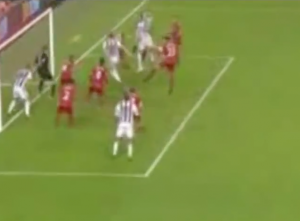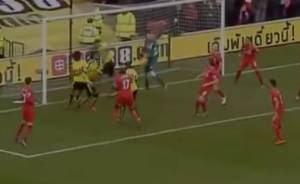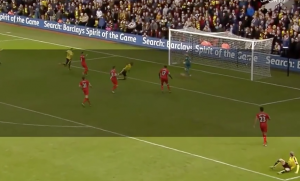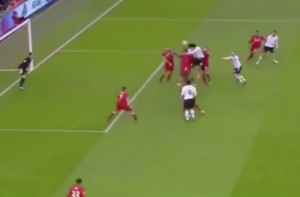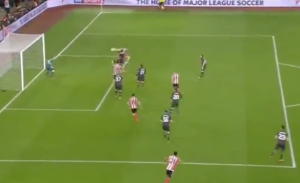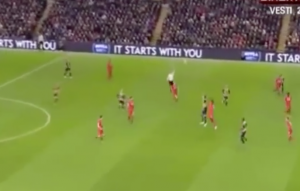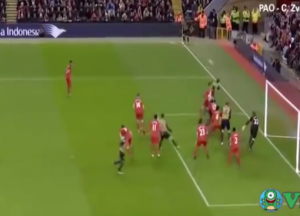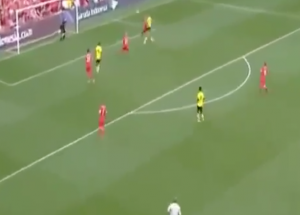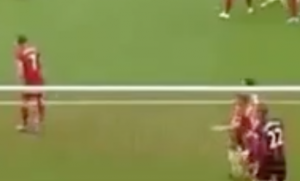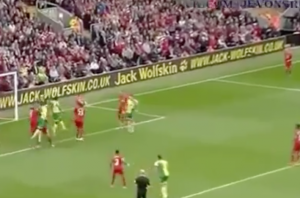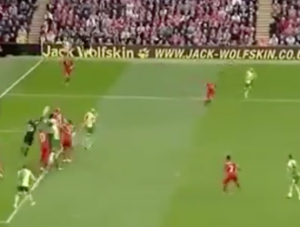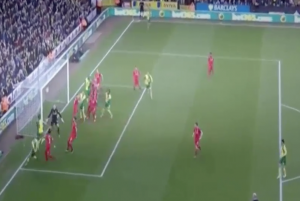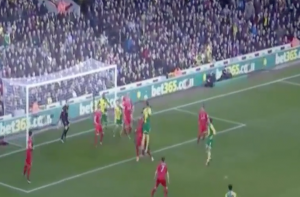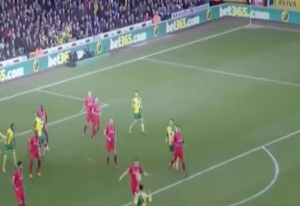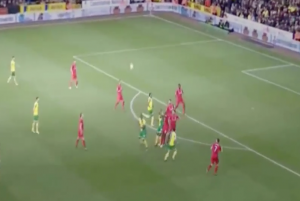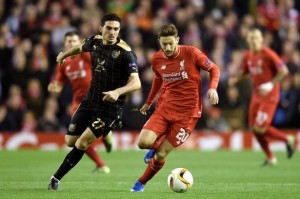By Paul Tomkins.
Believe me – I desperately wanted to drop the height issue, but what I have said on the subject has been picked up elsewhere and misrepresented (or misunderstood), including on Sky TV. I’ve got articles about other issues lined up, but for now, consider this the ramblings of a man driven to shouting, increasingly loudly, at someone who doesn’t understand, in order to stop himself going insane.
Read on if you dare, as it’s a dark, dingy and diminutive world…
Please note: In none of my examinations of Liverpool’s lack of height have I said that height is the only factor.
However, I’ve heard some ludicrous arguments that it “plays no part” in Liverpool’s woes; as if having a couple of tall players makes you a tall team, and height plays no part in aerial challenges because the occasional small lad can jump high, and other fallacious claptrap.
Data shows that, on average, very small players win a very low percentage of aerial duels. The following was from the subscriber-only content of my most recent piece:
“Of the 27 most vertically-challenged types in the 280-player study [of Premier League players which I undertook], I could find aerial duel win percentages for 18 of them – and the success rate is just 28%. Of the 42 players who are 173-176cm, the aerial win percentage rises to 39% (based on access to Opta data on 33 of the 43 players). Ergo, being slightly taller increases your odds of winning aerial duels.”
So, the odds of winning aerial duels improves with an increase in height. This is utterly logical. And yet being below average in height (the average height of a Premier League player is almost 6ft) means that you still have a below-average chance of winning aerial duels.
Yet people think of someone like Tim Cahill attacking a corner and assume that little (white) men can jump (Wesley). Some can, of course, but it’s harder to win defensive headers (from set-pieces) if you are small because it’s harder to attack the ball; you are likely to get caught under the ball and have to make a standing jump, rather than a running jump. It’s why defenders tend to be taller.
Naming outliers who are small but can jump really high, as people tend to do on Twitter (where they haven’t even read the piece), is missing the point; Liverpool don’t have such outliers. Or if they do, I must have missed the part where they were jumping really high. The assortment of short players at Liverpool are hardly Micah Richards or Fabio Cannavaro. For example, though he’s injured right now, Philippe Coutinho has the worst aerial duel success rate in the Premier League over the past two seasons, at c.10%. Most of the Reds’ others are a lowly c.20-30%, including two of the back four.
Let’s remember here that Peter Crouch, who will no doubt return on Tuesday to haunt me for saying this, is a bit of a rubbish header of a ball, and hardly had a springy leap even in his prime. But he holds the Premier League record for most headed goals (passing Alan Shearer’s record of 47 last year). Why? Because he’s freakishly tall. He’s 6’7″, taller than anyone else in the division. Nothing else, in terms of his aerial success rate. Being taller gives him an advantage over smaller, better headers of the ball, like Cahill, Les Ferdinand and Robbie Fowler, who scored a lot fewer league headers in their careers. And Crouch was no doubt better at defending set-pieces, too.
Sunday Nonsense
Apparently in response to my article last week, Martin Samuel suggested on the Sunday Supplement that having Sakho (merely average height for a centre-back at 6’2”) and Can (admittedly above average height for a central midfielder at 6’2”) means that Liverpool are “tall enough”; as if those two can therefore mark everyone. Liverpool are facing opponents who are 6’4” and 6’5”, and doing so with a back four that, Sakho aside, is 5’7”, 5’9” and 5’10”, and midfielders who are 5’7” (Coutinho), 5’8” (Lallana), 5’9” (Ibe, Milner) and 5’10” (Lucas). It’s easy to see why it’s hard to put Joe Allen (5’6”) in the side, even when he plays well on an individual basis.
If Benteke isn’t playing, and with the injuries to various other players (including three centre-backs), Liverpool have just three tall outfield players (Can, Sakho and Henderson), plus a couple of average-height players (Lucas and Toure) and you normally use between eight and ten to defend set-pieces. On top of this, Liverpool don’t have a commanding goalkeeper.
Liverpool have been smaller than the opposition in 14 of Klopp’s 15 league games. On average, the bigger the gap in height between the two teams, the greater the number of set-piece or headed goals the Reds have conceded. (Under Klopp, Liverpool have a far better win rate against smaller sides – roughly twice as good.)
Equally, I’ve said that a good few of the best Premier League players are small, and discussed some of them in that subscriber-only section. But they are often protected by bigger players (for example, Stoke’s average height remains huge, despite Bojan and Shakiri – something I wasn’t quite aware of until I did this thing called research; just as I discovered that Arsenal have a fairly tall team too. I spent days trawling through websites to find the heights of almost 300 Premier League players – although admittedly I didn’t personally measure them and chalk their inside leg measurements – and it’s waved off by someone who sees two tallish players in red and thinks that’s enough).
As I’ve been saying, Liverpool’s seven smaller players, as well as being poor in the air, haven’t been doing enough at the other end to compensate, although Lallana and Milner both getting goals and assists at Norwich was a step in the right direction (as have been Joe Allen’s two recent goals).
It’s one thing if you have Messi, Iniesta, Xavi, et al, and play in La Liga; it’s another if you have merely decent Premier League players who also happen to be small. And it’s another still if you have five or six of them in the team at once.
Having said that, both Man City and Leicester are doing well with smallish sides, but having said that, not as small as Liverpool (and they have fewer small players in their XIs, as you will see at the end of this piece). Leicester and Man City are also amongst the worst on set-pieces, having conceded from six and five corners respectively from corners (with five of the worst seven teams on this metric smaller than average). But their smaller players are generally doing more going forwards; to compare any of Liverpool’s smaller players, bar Coutinho at his very best, with Aguero and Silva would be unrealistic. (And of course, Sterling is better than most of the small Liverpool players he left behind; compare his goals record to Adam Lallana’s, for example.)
Of course, if Liverpool can’t improve their set-piece defending – and they need to try to (which takes time) – then the smaller players doing more at the other end will make a difference. To use an example of the last time Liverpool were, on average, this small, these players aren’t doing what Beardsley, Houghton, McMahon and Aldridge were doing in 1988 – scoring a ton of goals and being amongst the best players in England.
According to TTT and LFCHistory‘s Graeme Riley, in 2005/06 Liverpool were, on average, 1.86m in height; and, as I noted recently, Comolli and Dalglish added only tall players too (bar Craig Bellamy). But the average height fell every season under Brendan Rodgers, down to 1.79m last season. This may be the way that international football is going, but English football remains full of big, beastly sides. It’s not that Liverpool have rubbish small players, but bar Coutinho, none is even potentially remarkable (although Jordon Ibe could be in time). All of them have certain qualities, but do those qualities offer enough in a big, physical league?
Last season, and this season under Klopp, are the only times in the Premier League era that Liverpool have been below 1.80m on average. The biggest change was in Houllier’s second season, when he added almost five centimetres to the average height.
It may be coincidental, but in Liverpool’s four ‘tallest’ seasons since 1992 (each time averaging over 1.85m) the Reds have posted 80+ points twice (out of only three occasions they’ve achieved this), won the FA Cup, done the FA Cup/League Cup/Uefa Cup treble and won the Champions League, as well as also reaching the quarter-finals for the first time since the competition was rebranded, in 2002. With less access to the most expensive players on the market, the Reds were more resilient, and certainly bigger bastards than right now. And of course, as I mentioned last week, Klopp’s Dortmund were a big side too, even if people might mistakenly think otherwise.
(As an aside here, people keep telling me that certain Liverpool players are taller than I have noted, and that others are smaller. But I’ve used the official Liverpool site for Liverpool players.)
As previously noted, Klopp inherited a lot of small players. Brendan Rodgers had added height in Benteke, and was playing Gomez at full-back, which briefly helped make the Reds an average-height side overall. But the play was incredibly dull, much like last season. The Reds could be bullied, that was clear. Milner and Clyne are both strong, but both are 5’9”, and further reduced the average height despite what had been added up front in the new no.9.
In trying to make the Reds a better passing and pressing side, Klopp picks the smaller players; but also often out of necessity, given who has been fit. A tall centre-back – Steven Caulker – has been brought in, but he arrived with little match sharpness, which is presumably why Kolo Toure, whose general play has been fine, is still getting the nod. Weirdly, Caulker’s impact as a substitute striker is helping the Reds to a crazy goal every eight minutes he’s on the pitch, which, though unsustainable, shows the anxiety a bit of height can create, even in taller opposition defences.
Klopp’s Reds have been patchy, as they struggle to gel as a unit and learn new set-piece drills, but have scored three at Chelsea, four at Man City, five at Norwich and six at Southampton, whereas this season Rodgers’ Reds only looked exciting and with a cutting edge against Villa, on that rare occasion when Daniel Sturridge was fit. Klopp is trying to do what Rodgers couldn’t, and make Liverpool fire without Sturridge.
Equally, Liverpool have started conceding more set-piece goals, with Benteke often omitted. It’s an unfortunate trade-off – a kind of Sophie’s choice: a static striker who you play better without, or using that static striker as a defender on set-pieces. (Solution: find a better taller striker, or add a couple of taller player elsewhere, preferably at full-back.)
Goals, Goals, Goals
What follows is a look at the goals Liverpool have conceded to aerial situations this season, with my assessment of each situation and also an accompanying screenshot or two (of varying quality and resolution).
I make it 17 goals this season conceded to headers, corners, or directly following a lost aerial duel. Three of these were down to really bad goalkeeping, but nervous goalkeeping can come from nervous defending, and vice versa.
In several cases better defensive decisions would have helped, but to say that height plays no part is utterly wrong; even if it only plays 20 or 25 percent of a part, that’s a significant marginal loss, as opposed to a marginal gain. (And as Liverpool are often more than 20-25% shorter than their opponents, based on the range of Premier League team heights – i.e. between 178cm and 185cm based on every game I’ve looked at – then it’s an assumption that could well be valid.)
Mistakes were often made in other areas on these goals, but this piece is about how ruthlessly Liverpool’s mistakes are being punished because, once the mistake had been made (and you can’t totally eradicate mistakes), they stood little chance in the aerial duels that led to the goals.
(Note: No dwarfs were harmed during the writing of this article. Or dwarves, if you want to spell it in a non-Disney way. But some midgets may have been chained up in a sex dungeon, because clearly I have a fetish, according to a couple of people on Twitter. In fairness, they have might have a point…)
Crystal Palace
Scott Dann 6 ft 2 in (1.88 m) beats Roberto Firmino, 1.81 m (5 ft 111⁄2 in), to seal the win for Palace.
Height differential in challenge: 7 cm, or over two inches. (Weight difference: fucking huge.)
Notes: Firmino tries to block Dann but Dann (Dann) is just too big and strong. He uses Firmino for leverage, which keeps Firmino pinned down. Firmino is in no position to recover and Dann heads in the rebound.
Firmino, while one of the Reds’ taller players (but still under 6’0”), is also not very good in the air: his aerial duel win % is listed as just 25%. His movement, goals, assists and pressing make him a valuable asset but he’s not very good in the air.
(Note: most images can be clicked upon to see larger, although the original video resolution may have been poor to start with.)
Southampton (H)
Two headers are lost, before the ball is bundled home at the far post, to enable Southampton a late equaliser from a deep free-kick.
Jose Fonte – 1.87 m (6 ft 2 in) – wins the flick-on ahead of Roberto Firmino, 1.81 m (5 ft 111⁄2 in), who is one of the players shielding the edge of the box.
Height differential in challenge: 6cm, or 2 inches.
Next: Lucas Leiva 1.79 m (5 ft 10 in) out-jumped by Gastón Ramírez, 1.83 m (6 ft 0 in). First of all, it’s an incredible jump. Ramírez gets up incredibly early, as strikers can gamble and do (tougher for defender to go up early, as if he mistimes it he is effectively out of the play for a couple of seconds). It’s hard to see how a player who is 5’10” can stop a taller player leaping like this. Before Lucas can even react, Ramírez is three feet above him.
Height differential in challenge: 4 cm. Early jump advantage: huge.
Chelsea
Alberto Moreno, 1.71 m (5 ft 7 in), beaten in the air by Ramires 1.80 m (5 ft 11 in).
Height differential in challenge: 9 cm, or almost four inches.
Notes: This is poor defending by Moreno, who is caught on his heels. Ramires attacks the ball, which gives him power and momentum over a static Moreno. But a bigger, stronger full-back would logically stand much more chance of making life difficult for Ramires, if only by getting his (bigger) body in the way. Equally, a taller defender can stoop forward to try and head clear. Moreno isn’t just small, but he’s not great in the air.
West Ham (A)
Goal 1. Michail Antonio 1.80 m (5 ft 11 in) beats Nathaniel Clyne 1.75 m (5 ft 9 in) to head in a cross.
Height differential in challenge: 5 cm, or two inches.
Notes: Liverpool are a man light due to Moreno being fouled. The Reds fail to deal with the break down Moreno’s flank and allow the cross. However, once the cross is put in, Clyne is too small to deal with it. Antonio is bigger and stronger, and has a run on Clyne.
Goal 2. Andy Carroll 1.93 m (6 ft 4 in) beats Nathaniel Clyne 1.75 m (5 ft 9 in) to head in a cross. Michail Antonio is also challenging for the ball.
Height differential in challenge: 18 cm, or seven inches.
Notes: Moreno goes infield to press the ball and is caught out, allowing cross to come in. The chance of Clyne winning the header against an onrushing Carroll is 0.0002%. Indeed, Clyne is backpedalling, making it harder to jump, whereas Carroll is powering forward. It’s not just the difference in height, but the difference in weight, that makes it harder to deal with. It’s like a bicycle standing up to an HGV.
West Brom
Goal 1. Mignolet error from a corner. Bad punch. West Brom are the biggest team Liverpool have played this season (average outfield height of 185cm to Liverpool’s 180cm that day) and it’s plausible that this led to Mignolet being anxious to compensate. (Indeed, how do you measure nerves?)
Goal 2. Jonas Olsson 1.95 m (6 ft 5 in) loses Dejan Lovren 1.88 m (6 ft 2 in) in getting to near post to head in.
Height differential in challenge: seven centimetres, or almost three inches.
Notes: a poorly defended set-piece, but once Ollson – the tallest player on the pitch – gets his head to the ball it’s hard for anyone to do anything about it. The ball is good, and the height advantage helps Olsson.
Watford
Goal 1. Bogdan drops a corner and Watford stab it home. Later shown to be back in the keeper’s hands, but it all happened so quickly.
Goal 3. Moreno vs Igahlo, kinda. See notes.
Height differential in challenge: n/a.
Notes: Watford break, after Moreno loses a challenge infield. He follows ball centrally, leaving no one at left-back (Coutinho looks most suited to filling in but he doesn’t track back). Can, who has more ground to make up, runs to close down the Watford player in acres of space but cross comes in before he can get there. Sakho has to cover across, which he does, but cross then goes over his head into the space behind. Moreno ends up as the closest to Ighalo (5’11”), but cannot get close enough to make a challenge.
Man United (H)
Marouane Fellaini 1.94 m (6 ft 4 1⁄2 in) gets above four Liverpool players (Sakho, Henderson, Lucas and Toure) to head against the bar. Rebound falls to Wayne Rooney. Only one of the four Liverpool players listed is above 6’0”: Sakho, 1.87 m (6 ft 2 in).
Height differential in challenge: 7cms, or almost three inches.
Notes: This is easy to put down as bad defending, which it is; but what is the psychological issue here? All Liverpool’s players get drawn to the tallest player on the pitch, who is almost three inches taller than anyone in a red shirt. None of these Liverpool players are above average in the air; indeed, Toure’s aerial duel win percentage is 42%, whereas a good centre-back’s should be up around 70%.
Statistically, Sakho is worse in the air than Lovren and Skrtel, although he did win a lot of headers versus United by absolutely chucking himself at them: but the one perfect ball, the one perfect leap, and Fellaini was unstoppable. Not for the first time, Liverpool were drawn towards the threat, and then when the ball broke loose, were out of position.
But had those four not challenged Fellaini, to at least put him under more pressure than a single defender could, perhaps he heads straight in. (Unless you feel that the quartet just got in each other’s way and made it easier for him.)
Southampton League Cup (A)
Goal. Tadic makes a mug of Emre Can, and Sadio Mané 1.75 m (5 ft 9 in) gets above Alberto Moreno, 1.71 m (5 ft 7 in).
Height differential in challenge: 4 cm.
Notes: Again, Moreno is out-jumped, having been caught on his heels. The cross should have been stopped by Can, but Moreno seems to have a problem defending against players who have a run on him, when he is caught under the ball. Clyne seems to have a similar problem, and maybe that’s just the difficulty of defending. A lack of height clearly adds to the problems, as taller, stronger players can do more to put off an attacker.
Arsenal (H).
Goal 1. Goal stems from an initial aerial challenge between Oliver Giroud 1.92 m (6 ft 4 in) and Mamadou Sakho 1.87m (6 ft 2 in).
Height differential in challenge: 5cm, or 2 inches.
Notes: I include this one because Sakho lost the header to the taller man, which resulted in a clash of heads. Sakho is still clearly dazed as Arsenal feed the ball through to Ramsey.
Goal 2. Arsenal appear to score direct from a corner, but it transpires that Oliver Giroud gets a touch. Giroud is bigger than Sakho, and holding him off, while Adam Lallana 1.72 m (5 ft 8 in), misses the ball at the near post.
Height differential in challenge: n/a
Notes: Again, if Lallana was 6ft he probably cuts it out as the near-post man. But the five, six and even seven smaller players Liverpool field have to do something at set-pieces.
At the other end, Liverpool had been working the old, lofted Gary McAllister near-post corner in recent weeks, but Arsenal put Per Mertesacker 1.98 m (6 ft 6 in) on the front post in response. Arsenal had two players – Giroud and Mertesacker – who were significantly taller than anyone in the Liverpool side.
Overall, Arsenal were 3.6cms taller than the Reds on the night. Liverpool had just five outfield players as tall, or taller than 177cm – or 5’10”; Arsenal had eight, including both full-backs.
Aston Villa (H)
Goal: High cross is swung in from the Reds’ right. Rudy Gestede 1.93 m (6 ft 4 in) gets above Alberto Moreno, 1.71 m (5 ft 7 in) to head in.
Height differential in challenge: about 10,000 inches.
Notes: It’s hard to see what a 5’7” full-back can do against a 6’4” striker who is powering in to attack the ball. Remember, in almost all of these situations the full-back is under the ball, and the person attacking it is getting a run. Defensive heading is different from attacking heading, because defenders often can’t run towards a cross to get momentum.
This is one from Rodgers’ tenure, but it shows that once the cross comes in, the full-back is 80% powerless (at a guess). Blocking the crosses is important, but you won’t be able to block every cross.
Norwich (H)
Goal: Simon Mignolet comes out and punches over a crowd of Liverpool defenders, the nearest to him being James Milner, who is marking a zone on the edge of the six-yard box. Russell Martin then lobs the ball into the back of the net.
Height differential in challenge: n/a.
Notes: Another one from Rodgers’ tenure, this is one of three rank-bad goalkeeping errors from corners, although the least worst of the three, given that he got something on his punch.
Norwich (A)
Goal 1: Norwich corner goes beyond the far post, and Nathaniel Clyne 1.75 m (5 ft 9 in) loses out in the air to Russell Martin, 6 ft 1 in (1.85 m), although Steven Naismith (also taller than Clyne) is there too.
Ball comes across box, and Kolo Toure 1.78 m (5 ft 10 in) loses header to Dieumerci Mbokani 1.85 m (6 ft 1 in). Panic ensues. Milner 1.76 m (5 ft 9 in) then gets nowhere near to the third aerial challenge on the edge of the box – against Jonny Howson, 5 ft 11 in (1.80 m) – after Henderson had headed clear. Four headers in the box; Liverpool lost three of them, all three to a massive height disadvantage.
Height differential in challenge: 10cms on first challenge; 7cms on second challenge; 4cms on third challenge.
Notes: Poor defending to end up with Clyne versus two at the far post, but then mostly about being out-jumped by taller players. Sakho could maybe challenge Mbokani, but risks giving away a penalty if he goes through him.
Goal 2: Sébastien Bassong 1.87 m (6 ft 2 in) challenges in the air on an up-and-under with Mamadou Sakho 1.87 m (6 ft 2 in). Ball bounces of Sakho’s leg, falls nicely to Bassong who blasts home.
Height differential in challenge: none. Equal match.
Notes: One of the only situations – indeed, perhaps the only one – where Liverpool concede following an aerial threat where there was no height disadvantage. Bassong backs off, and Mbokani nudges Sakho from the side, who mistimes his jump.
This brings me back to the issue of defenders jumping early in anticipation – if they wait, they can get “run on” by an attacker; if they jump early then they have to time it to perfection, otherwise they can’t react.
(I remember being at Villa Park in 1998 when Robbie Fowler scored a hat-trick. A very young Gareth Barry, playing centre-back, went up early for a cross and Fowler just hung back, guessing that the teenager would mistime his jump and miss the ball. Have a look here.)
Conclusion
So there you have it. Feel free to browse earlier articles, including this one, to see further points I’ve made on this subject. Alternatively, look only at Liverpool’s two or three tall players and assume that the small two-thirds of the team is irrelevant.
As I said in the Arsenal section, Liverpool had just five outfield players as tall, or taller than 177cm (5’10”), that night (as they have on other occasions). At a quick glance through the numbers other teams fielded against Liverpool, West Ham had seven, while Watford and West Brom had no fewer than nine. Are you telling me it’s easy to mark and match-up in these situations?
With this in mind, I thought it would be an idea to go through and see how many players as tall (or taller than) 5’10 each team had fielded in Liverpool’s games since Klopp arrived. Liverpool have fielded either five or six such players in all of those 15 league fixtures – never more, never less (although there were only four in the League Cup win at Stoke). Only once has an opponent fielded as few ‘short’ players as Liverpool: Swansea, who also fielded five on that occasion.
Otherwise, there have been five games where the opposition fielded one more such player than Liverpool; four games where they fielded two more than Liverpool; four games where they fielded a whopping three more than Liverpool; and finally West Brom, who fielded four more than the Reds (hello, Mr Pulis).
Most of the time, the Reds could only field five players who are at least the average height of a British male; which is smaller than the average height of a Premier League player.
Remember, I’m not saying height is everything; just that to say it’s nothing is illogical.
(Right, time to open the dungeon doors…)
